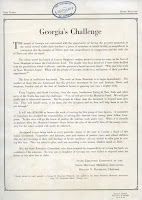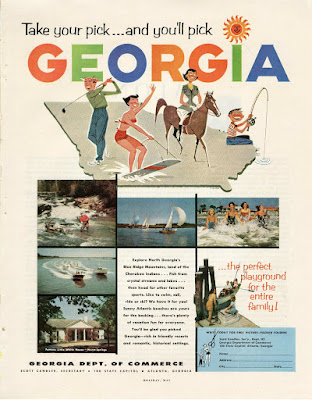Over the past two summers Russell Library intern Kaylynn Washnock assisted in curating the new exhibit, “Seeing Georgia: Changing Visions of Tourism in the Modern South” opening September 18th in the Russell Library’s Harrison Feature Gallery. The exhibit investigates how the state transformed itself from a way station along the route to Florida into a tourist destination during the twentieth century. It addition to highlighting six popular destinations in Georgia the exhibit considers questions of access, preservation, and economics – who could go, how they got there, and what motivated them to visit different attractions. The exhibit also explores the professionalization of the tourism industry and the roles of modern amenities in shaping the modern tourist experience. This post is one in a series where Kaylynn offers a preview of the exhibition.

Since the 1850s, people have come to marvel at the world’s largest mass of exposed granite at
Stone Mountain. In 1909, at the height of Civil War memorial construction in the South, the United Daughters of the Confederacy proposed a monument on the site. The Stone Mountain Confederate Monumental Association hired renowned sculptor
Gutzon Borglum, creator of Mount Rushmore, to construct a carving of well-known Confederate figures Jefferson Davis, Robert E. Lee, and Thomas J. “Stonewall” Jackson. Following ongoing disagreements, Borglum left the project in the 1920s with the carving incomplete.
Given recent events in the media concerning Confederate flags and monuments, it is interesting to reflect on the origins of the carving at
Stone Mountain. In 1924, the Stone Mountain Memorial Association (SMMA) announced “the people of Georgia are confronted with the opportunity of having the greatest memorial in the world erected within their borders—a piece of sculpture so heroic in size, so magnificent in conception that the temples of Thebes pale into insignificance in comparison and the rock city of Petra can offer no equal.” Hoping to raise $250,000 to finance the carving, SMMA chairman Hollis H. Randolph urged “when will the people of Georgia awake to a realization of their priceless opportunity?” The 1920s vision for Stone Mountain was a product of its time, steeped in notions of Lost Cause ideology.
The Civil Rights Movement revived attention in the unfinished monument among pro-segregationists. In 1958,
Governor Marvin Griffin led efforts to establish the Stone Mountain Memorial Association (SMMA) to purchase the property and oversee the development of Stone Mountain Memorial Park. The 1959 Master Plan completed by Robert and Company Associates of Atlanta hoped to transform Stone Mountain with the construction of a lake, dam, scenic drives and trails, fishing pier and open-air theater.
Since the 1970s, Stone Mountain has attempted to move beyond promoting a romanticized and largely conflict free vision of the Old South. Although the Confederate carving remains prominent, and
an interpreted antebellum plantation is among the featured attractions at the site, developers have created a more marketable identity for the park as a whole to appeal to a culturally diverse audience. In 1998, Herschend Family Entertainment, owner of Dollywood and Silver Dollar City, signed a contract to operate Stone Mountain as a joint public-private family friendly theme park, which now attracts 4 million visitors annually. The park offers a host of attractions, including a laser light show, sky lift, scenic railroad, in addition to hiking trails, a golf course, and fishing and picnicking areas. Though not without controversy, the modern site is more than just Confederate memory.
Interested in talking more about issues of memory? Our pick for September's
Rest of the Story Book Club is
Confederates in the Attic by Tony Horowitz. I'll be helping to lead the discussion, so if you're interested in further exploring the topics touched on in this blog post, check out the book and join us on
Tuesday, September 22nd at 5:30PM for light refreshments and good discussion.
Want to find out more about Georgia Tourism? Visit
Seeing Georgia: Changing Visions of Tourism in the New South on display in the
Harrison Feature Gallery in the
Richard B. Russell Building Special Collections Libraries from September 18, 2015 through July 30, 2016. The Russell Library gallery is free and open to the public weekdays from 8 a.m.-5 p.m. and on Saturdays from 1-5 p.m. For more information, email
russlib@uga.edu or call 706-542-5788










